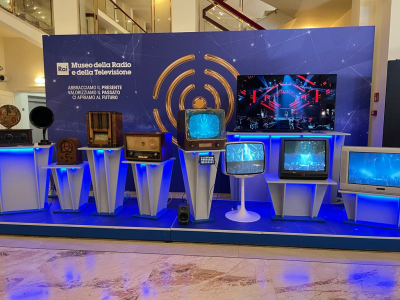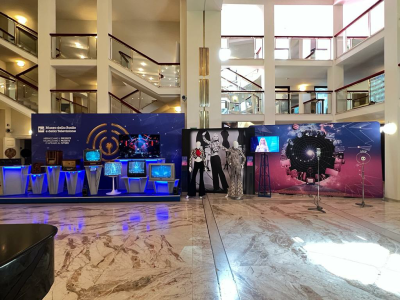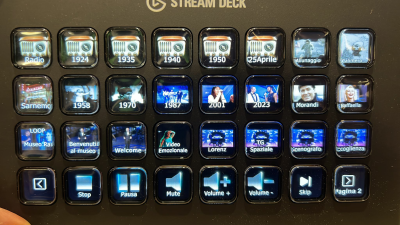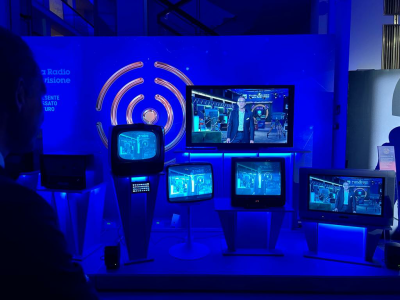Video Mill - Helps Tell the History of Radio and Television
"I could achieve the same result with a digital signage
solution but it would have been less flexible and cost 50 times more."
Andrea Del Principe, Advanced Projects Director, Rai - Radiotelevisione Italiana
History of Radio and Television exhibit at Donizetti Theater, Bergamo Italy
powered by
Video Mill
and
Sound Mill
The Requirements
Andrea Del Principe of Rai Italia (Italy's equivalent to Britain's BBC) led this project at the Historic Donizetti Theater in Bergamo Italy to create a multi-media exhibit. It tells the History of Radio and Television by using the technologies available through the years. The solution requirements included the following:
- Play different audio and video clips on 10 different devices (radios and televisions from the 1920s to present day). (Figure 2)
- Control the exhibit via an Elgato Stream Deck with 32 buttons (Figure 1). Press a button to hear or view a clip on one device or sometimes multiple devices.
- The exhibit is intended to be visitor driven. Each visitor can decide which audio or video they want to experience by clicking a button.
- The visitor can hear how each of the period radios sounded with audio coming through its own speakers.
- Media clips are played of well known news and events of the day on each device.
- The solution must be controlled by a computer hidden behind a kiosk stand using standard connection wires. No other specialty hardware should be required.
- The exhibit will be used for 2 purposes: 1) As an unattended kiosk for visitors to explore, 2) For guided museum tour demos given by a trained operator.
- They also wanted to have each video complete its playback before the next video could be started.
The Video Mill/ Sound Mill Solution

Video Mill and Sound Mill hit the mark on all the requirements.
- One of the Elgato Stream Deck's features is the ability to send keystroke signals (ex. Control+P) when a Stream Deck button is pressed. Each button can be programmed with a unique key combination (aka key shortcuts).
- Video Mill can be configured to listen for keystrokes and based on the key shortcut, play a video or run an automation script. So each button maps to a specific video.
- For the radios, Sound Mill is used. Sound Mill has the ability to channel audio to different USB connected soundcards. The museum already owned a custom made soundcard device that could redirect audio to each of the radios. Note that Sound Mill can also use a standard USB Hub with inexpensive USB soundcards (ie about $5-10 each) to redirect audio.
- Video Mill controls the automation by sending simple play commands to Sound Mill when a button for an audio clip is pressed.
- Video Mill can also programmatically turn on/off its listening for keystroke signals. This solves the requirement to let each video complete its playback before the next button press starts another video.
- The Stream Deck offers multiple 'Pages' of button mappings. So they use different pages of buttons depending on how the kiosk is being used: 1) As an unattended kiosk (a more restrictive page); 2) For a guided tour demo (full access page).
Here is an article announcing the opening of the Donizetti Theater, History of Radio and TV Exhibit. (Written in Italian - You may need to use your browser's language translation feature.)
Watch the Companion Video
 See the companion Youtube video that show the exhibit in action.
See the companion Youtube video that show the exhibit in action.
Endorsement
Andrea Del Principe, Advanced Projects Director, Rai - Radiotelevisione Italiana"The great versatility of these software products [ Video Mill and Sound Mill ] and an excellent support service allowed us to control five video outputs and four audio output in the Hisotirc Donizetti Theater in Bergamo. We liked the possibilities of programming every action of the software in a clear interface."
Editor's note: Andrea Del Principe also happens to be a world class tenor often doing international tours. Read more at his Website. And Andrea is not only an amazing singer, he did all the technical implementation for this project. Salute Andrea!
Gear
- Laptop Computer: Off-the-shelf, Windows 10.
- Television: Models from 1950s to present day.
- Television connections: HDMI to computer.
- Radios: Models from 1920s to 1950s.
- Radios connections: Via USB connected custom-made audio box.
Product Information


 Home
Home News
News Support
Support Contact Us
Contact Us Site Map
Site Map Search
Search About
About Page Bottom
Page Bottom



 To Page Top
To Page Top